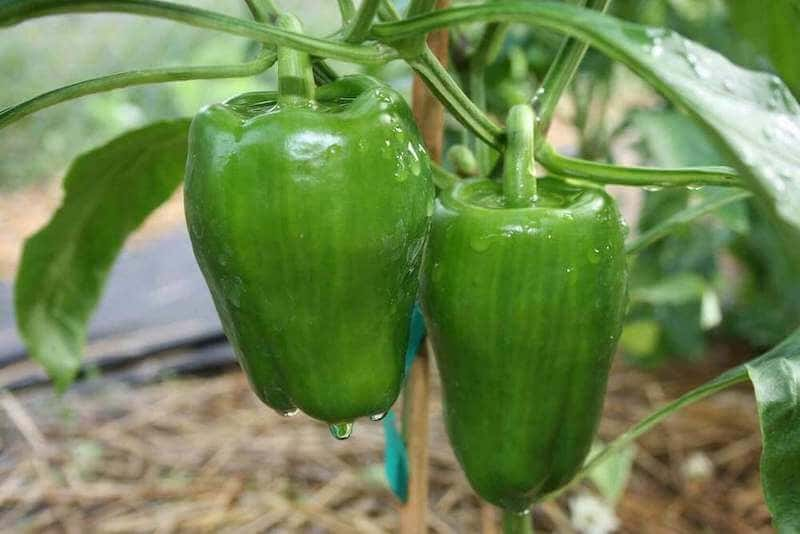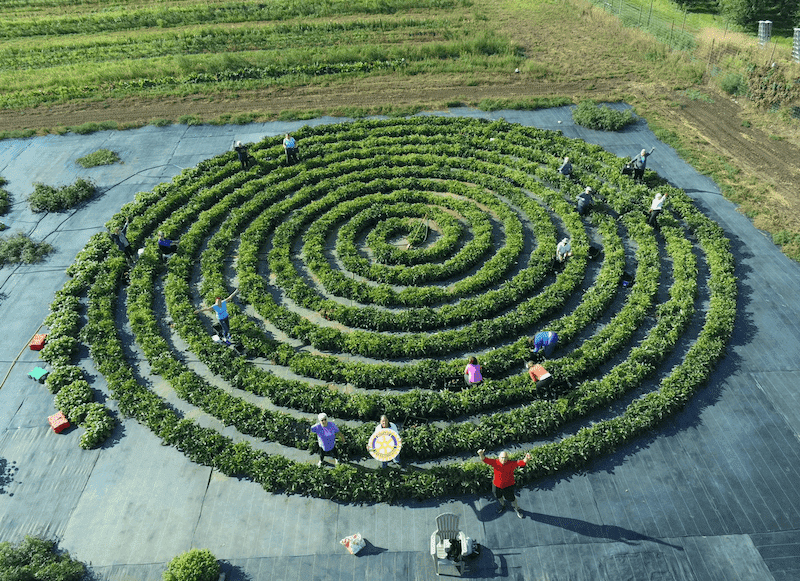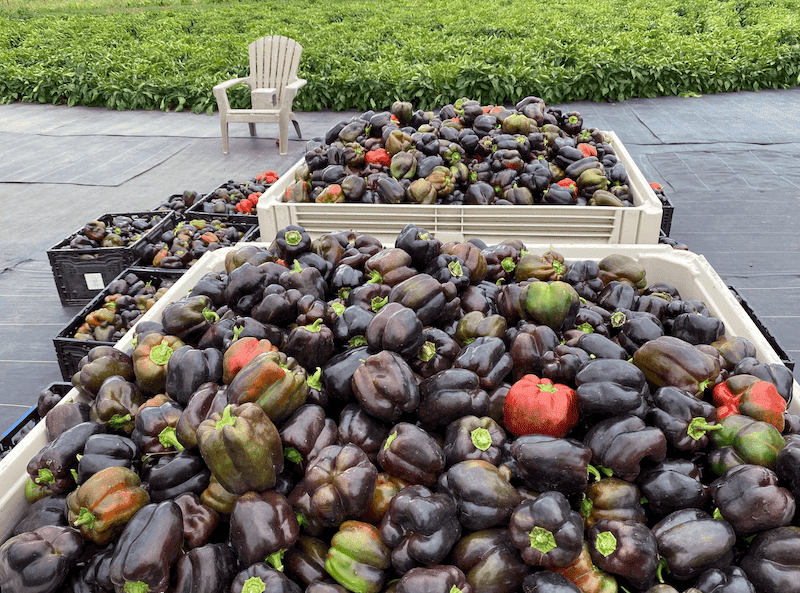
More than 70% of the world's bell peppers are produced in Asia. China is the largest producer of bell peppers, followed by Mexico and Indonesia. California is fourth leads all states in bell pepper production. In the states, most bell peppers are produced by open field agriculture, which produced 2 billion pounds of bell peppers on 60,000 acres. Even with all this production, the U.S. imports 70% of its bell peppers, most imported from Mexico.
In the north, peppers are grown in greenhouses due to the climatic imitations of open filed agriculture in winter. Further north in Canada, almost all bell peppers are grown in greenhouses. Called “hothouse” peppers, they represent just 30% of the market – the rest are imported from Mexico other central American countries like Peru.
Bell peppers can be an extremely profitable crop to grow but can be risky due to several factors, one of which is tendency to drop its pepper blossoms in cool night temperature. Pepper plants are particular about soil, requiring just the right mix of ingredients to grow properly and set large fruit. Peppers grow best on well-drained soils that have good water holding characteristics and a pH of 5.8 to 6.6. Phosphorus, potassium, and lime should be added at a 10:10:10 all purpose fertilizer ratio. Alternatively, Epson salt may be added to the soil before transplanting young pepper plants.
Epsom salt is hydrated magnesium sulfate; it contains 10 percent Magnesium and 13 percent Sulfur. Magnesium increases water retention, helps in better intake of nutrients, and most importantly in the creation of chlorophyll. Sulfur also participates in chlorophyll development, in photosynthesis and boosts the plant’s growth and its resistance to diseases. The addition of Epson salts grows bigger, more robust plants that are lusher and greener than before (due to the boost in chlorophyll production), and induces larger and tastier fruits.

Farm peppers are grown in open fields in parallel cultivated rows, which are predominately irrigated by flooding furrowed trenches between the rows. Flood irrigation uses and wastes a tremendous amount of water. Where water supplies are limited, rows of pepper plants are irrigated by a drip system, which uses significantly less water, however in California, where the state is clearly running out of water, drip system irrigation will not work with new water restriction guidelines.
Pepper plants and their peppers are delicate and susceptible to sudden storms with excessive wind, hail, and rain and as climate change continues unabated, unpredictable weather is commonplace. Shadowing between rows creates unbalanced sunlight patterns that affect plant growth and yield. Just a fraction of the bell peppers grown in the U.S. are grown organically leaving the remainder grown with the use of pesticides, herbicides, and methyl bromide soil fumigant.
Growing peppers in open fields can present several environmental problems for farmed peppers, including:
To address these challenges and minimize environmental impacts, sustainable farming practices should be employed. This can include using integrated pest management techniques, employing crop rotation and cover cropping, or using efficient irrigation and plant propagation techniques offered by Crop Circle Farms.
Although seemingly greenhouse production mitigated the risk of growing peppers because plants are protected from the outside elements, other considerations come into play that could curtail yields.
Given the current state of the world and rising energy costs, growing peppers in greenhouses has become significantly more expensive. There is a limit to how much can be passed onto the consumer and wholesalers seem unwilling to budge on prices paid to growers, forcing some hothouse pepper producers to close.
A fungal outbreak can ruin an entire crop. If caught early, infected plants can be culled from the production line but if the infection cannot be contained and an outbreak occurs, all the plants will be lost and the entire contents of the greenhouse including soil and equipment must be removed and/or fumigated.
Growing greenhouse peppers can have some environmental concerns, including:
To address these concerns, greenhouse pepper growers can take several steps, such as using energy-efficient technologies, selecting varieties with thicker skins and longer shelf lives, and using sustainable growing practices. Additionally, selecting non-genetically modified seed and using open-pollinated or heirloom varieties can help reduce dependence on seed companies and promote seed-saving and sustainable farming practices.

The days access to cheap resources seem to be coming to an end. Farms facing severe water restrictions are shutting down, greenhouses are being priced out of business and fertilizer has tripled in price if you can get it.
A Crop Circle Pepper Farm was created with these planet changing issues with foresight to what might come to pass with the knowledge that it was going to affect all of us in food supply.
The first and probably most important issue addressed by a Crop Circle Farm ® is growing peppers with far less water. Proprietary Crop Circle Irrigators ®cradle plants and contain natural base liquid nutrient at the plant root enabling the uptake of nutrient as required by the plant. This means plants devote energy for growing canopy and fruit instead of root. This targeted delivery of nutrient uses 90% less water and 95% less fertilizer than rowed field agriculture growing peppers.
Second is the permeable dark colored ground cover used to supress weed growth, protect and build soil and limit evaporation and act like a “heat sink” to retain under canopy moisture and hold nighttime temperature above 70 degrees to prevent blossom drop.
Third is the design. Instead of growing peppers in rows, pepper plants are grown in large looping spirals, which by design prevent damage from sudden weather changes, especially excessive wind blow caused by sudden storms. Spiral pepper planting virtually eliminates shadowing between rows as the sun tracks across the sky.
The design combined with the proprietary irrigator system and soil structure best practices grow bigger plants that yield more peppers - in some cases 4 times as much compared open field pepper production. Higher yield means that there are excellent money-making opportunities growing peppers in the States on small parcels of land right where most of the buying public live - in towns and cities.

Much like tomato production, a Crop Circle Pepper Farm exceeds the production of both greenhouse and open field pepper cultivation.
A 1/27th of an acre Crop Circle Pepper Farm covers a 40-foot by 40-foot area and grows 700 pepper plants yielding an averaging of 10 peppers per plant (3,500 pounds) on average and revenue between $3,500 for green bell peppers and $10,500 for colored bell peppers.
A quarter acre Crop Circle Pepper Farm covers a 100-foot by 100-foot area and grows 6,000 pepper plants yielding an averaging of 10 peppers per plant (30,000 pounds) on average and revenue between $30,000 for green bell peppers and $90,000 for colored bell peppers.
A half-acre Crop Circle Pepper Farm covers a 150-foot by 150-foot area and grows 10,000 pepper plants yielding an averaging of 10 peppers per plant (50,000 pounds) on average and revenue between $50,000 for green bell peppers and $150,000 for colored bell peppers.
An acre Crop Circle Pepper Farm covers a 200-foot by 200-foot area and grows 18,000 pepper plants yielding an averaging of 10 peppers per plant (90,000 pounds) on average and revenue between $90,000 for green bell peppers and $270,000 for colored bell peppers.
Average Yield Comparison Per Row Farm Acre
Ready to transform your land into a high-yield, sustainable farm? Let Crop Circle Farms design and build a custom, low-impact, and water-efficient farm tailored to your needs. Double your income and cut your costs in half! Contact Us
Help us expand our mission to revolutionize agriculture globally. We are seeking partners to implement Crop Circle Farms to feed people in need. Together, we can build scalable food production systems that save water, reduce costs, and feed thousands of people. Contact Growing To Give